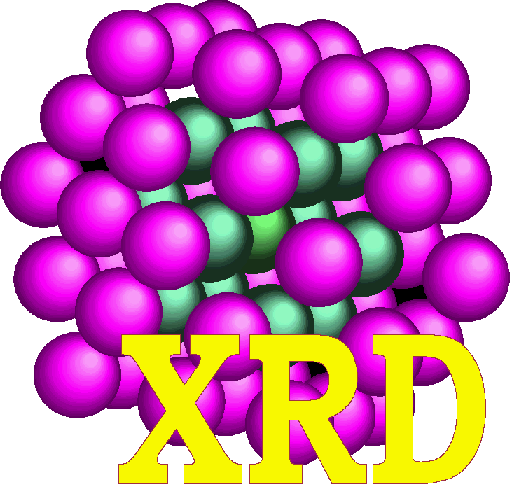Research
Powder nanocrystallography (principles)
During the last century developements of powder diffraction were based on the theory of crystallography but constructed as a phenomenological methods using several approximate formulae. They describe temperature effects, microstrain, crystal size etc.
Theoretical principles of powder diffraction can be derived from the Debye summation formula. Computational power of contemporary computers makes now possible testing of the widely used approximate methods via construction of a complex atomistic structural model and direct calculation of its diffraction pattern. The model can involve strain, defects and its time evolution can be monitored via molecular dynamics. Such tests [1,2,3] prove that even fundamental laws (e.g. Bragg Law, Debye-Waller (D-W) effect) become less accurate and applicable when decreasing crystal size. E.g. Rietveld refinement method, even if well convergent, is not suitable for trustworthy description of nanocrystal structure.
For small size nanocrystals (D<10-20 nm) the observed lattice parameter usually depends on the size (as proven for nanometals), the peak position does not correspond to the real interplanar distance and different peaks point to different lattice parameters. Microstrain has different than in bulk character and is mostly linked to the crystal surface, size induced polimorphic transitions may occur and atom thermal oscillations at the surface may seriously modify classic form of the D-W effect. Along with that we can observe surface reconstruction, concentration gradient of elements e.g. in surface segregation, partial amorphisation etc.
This is why powder diffraction of small nanocrystals requires new, different than classic methodologies, and atomistic simulations are well posed for their fundamental test.
Such tests suggest that the structural effects although complex, can be effectively studied during evolution of several experimental parameters like temperature or gas composition. The latter is especially important as nanocrystals having large surface to bulk atom ratio have their structure very sensitive to the gas atmosphere. This is why the suggested experimental methods are in situ ones. Analysis of a single diffraction pattern and derivation of material parameters have to account for all possible diffractometric errors and the results have often limited accuracy. On the other hand the study of evolution and measurements of differences are much more precise- most of diffractometric errors is repeatable and cancel out in difference. The overall precission is then mostly due to measuring statistics.
The method proposed by my group focuses on adapting the measurement strategy to address the most interesting structural motifs in chemistry- structure of the surface. Often it is the only part of the material that is modified. It already enabled analysis of surface reconstruction of Pt nanocrystals during hydrogen desorption [4] and NO chemisorption [5] explaining the discovered phenomenon of a low temperature Pt coallescence. We have proposed general method for detection of the surface reconstruction phenomenon on metal nanocrystals [6]. In studies of nanoalloys we have achieved control of elements segregation in PdAg enabling repeatable and reversible segregation and its atomistic model interpretation. The study allowed insight into elementary diffusion phenomena running in the nanocrystal and their mechanism - different than vacancy driven [7].
The proposed tools of nanocrystallography can be applied within the so called pressure and material gaps- conditions not often accesible for other experimental techniques.
References:
[1]. Kaszkur Z., J.Appl.Crystall., 33 (2000) 87.
[2]. Kaszkur Z., Mierzwa B., Pielaszek J., J.Appl.Crystall., 38 (2005) 266 .
[3]. Kaszkur Z., Zeitschrift für Kristallographie, 23 (2006) 147.
[4]. Rzeszotarski P., Kaszkur Z., Phys.Chem.Chem.Phys., 11 (2009) 5416.
[5]. Kaszkur Z., Rzeszotarski P., Juszczyk W., J.Appl.Crystallogr., 47 (2014) 2069.
[6]. Kaszkur Z., Mierzwa B., Juszczyk W., Rzeszotarski P., Łomot D., RSC Adv., 4 (2014) 14758.
[7]. Kaszkur Z., Juszczyk W., Łomot D., Phys.Chem.Chem.Phys.,17 (2015) 28250.



